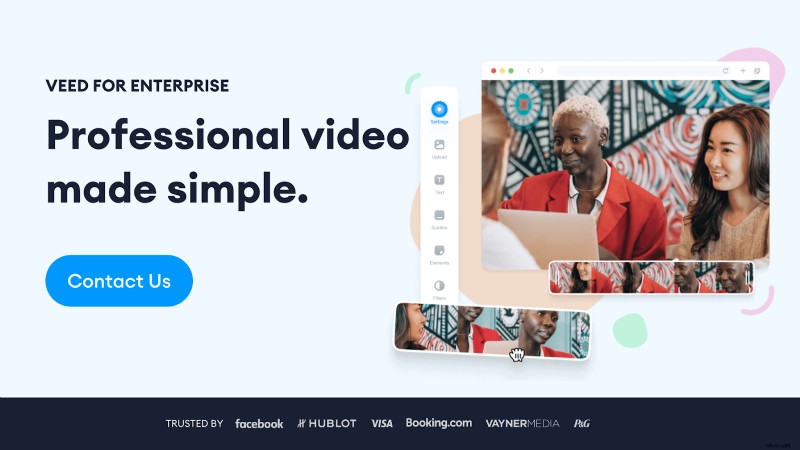Los videos de capacitación le ahorran tiempo y lo ayudan a evitar dolores de cabeza al incorporar nuevos miembros al equipo. También son útiles para otros tipos de comunicación interna.
En este artículo, compartiremos por qué todas las empresas necesitan hacer videos de capacitación, cómo su empresa puede beneficiarse exactamente de los videos instructivos y cómo empresas como la suya pueden hacerlos.
Por qué crear vídeos de formación
El video es el formato de contenido más atractivo, ya sea que sea un estudiante visual o auditivo. Puede mirar y escuchar el contenido de un video, mientras lee el texto en pantalla, los subtítulos o sigue una transcripción.
Si está tratando de optimizar una parte de los documentos de capacitación de su empresa, los videos de capacitación son la opción más inteligente.
Afortunadamente, ahora vivimos en una época en la que cualquiera puede hacer videos fácilmente con solo hacer clic en un botón. ¡No tiene que pensar en descargar archivos grandes, software complicado y aprender todos los atajos de teclado!
¡Ahora puede ver un video instructivo con un proceso detallado paso a paso y terminar de editar en unos minutos!
Beneficios de crear un video de capacitación
¿Todavía no estás seguro de cómo los videos de entrenamiento pueden hacerte la vida más fácil? Aquí hay más beneficios de hacer un video de capacitación.
- Más interacción: Los materiales de aprendizaje basados en videos pueden involucrar tanto a los estudiantes visuales como auditivos. Esto puede conducir a una mayor participación de los espectadores.
- Aumentar la retención del aprendizaje: Los espectadores pueden retroceder cuando sea necesario. A diferencia de la capacitación en persona, siempre pueden volver a visitar la capacitación cuando lo deseen.
- Ahorre dinero: No es necesario pagarle a alguien por capacitación en persona cuando puede hacer clic para ver el video.
- Conveniencia: ¿Te perdiste un entrenamiento? Mira la repetición. ¡Comparta el archivo con cualquiera que también se lo haya perdido!
- Contenido impecable: Vuelva a grabar partes del video en las que cometió un error para lograr resultados impecables. La belleza del video es poder volver a trabajarlo hasta que esté satisfecho con él.
- Ahorre tiempo: No es necesario estar en algún lugar dentro de un marco de tiempo establecido. Haz las cosas en tu propio tiempo. Un horario flexible es clave para los equipos remotos globales con muchas zonas horarias para equilibrar.
Cómo hacer fácilmente un gran video de entrenamiento con VEED
Es hora de aprender a hacer un video de entrenamiento. Entonces, ¿qué herramienta deberías usar?
La mejor herramienta es aquella que:
- Se adapta a las necesidades de su empresa en cuanto a funciones
- Funciona con el nivel de habilidad de creación de video de quienquiera que haga el contenido
Para hacerlo más fácil, le enseñaremos cómo hacer videos de capacitación con VEED, nuestro editor de video en línea simple pero poderoso. VEED ayuda a las personas de todos los niveles a crear fácilmente videos profesionales llamativos.
¡Comencemos!
Paso 1:Elija el tema de su video de capacitación.
Si puedes, elige un tema específico. Un enfoque claro hace que sea más fácil mantener el video conciso. O bien, puede ir tan amplio como desee y dividir el tema en fragmentos de videos más digeribles.
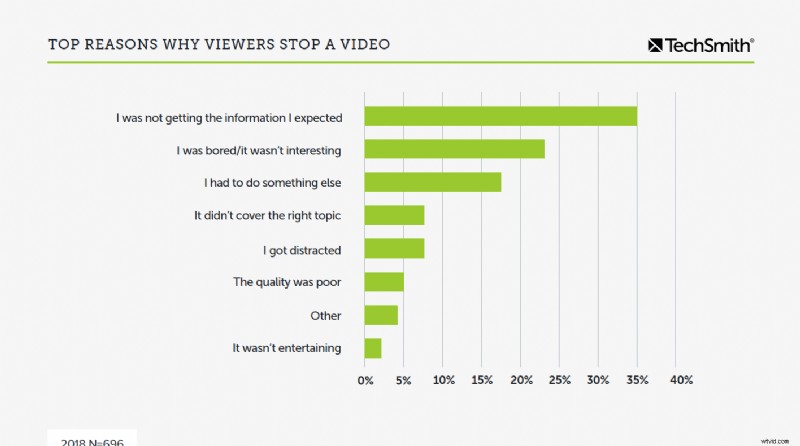
Por ejemplo, supongamos que su empresa quiere capacitar a los nuevos empleados en seguridad de la información. La privacidad de datos sería un buen tema específico. La idea es que no debe hablar sobre muchos temas en un solo video porque es demasiada información para procesar de una sola vez.
Paso 2:Elige el tipo de video de entrenamiento que quieres hacer.
Diferentes videos sirven para diferentes propósitos. Y algunos videos requieren más tiempo para crear que otros (como una simple grabación de pantalla versus una animación). Aquí hay 7 tipos de videos que puede usar para capacitación y contenido de videos educativos.
Videos de presentadores (Talking Head)
Este tipo de video de entrenamiento involucra un objeto o una persona en movimiento frente a la cámara. Esto es perfecto para cuando tiene un orador carismático que se siente cómodo frente a la cámara y puede mantener a los nuevos empleados comprometidos con la capacitación.
Vídeos animados
Este video utiliza imágenes completamente animadas, como gráficos, texto e íconos. Los videos animados son mejores para explicar tutoriales, ideas y datos complejos. Piensa en ellos como una infografía convertida en video.
Videos de capturas de pantalla
Un screencast simple (o grabación de pantalla) suele ser la forma más rápida, fácil y económica de crear un video. Estos son especialmente buenos para videos informales para comunicarse con un compañero de trabajo. También puede producir un video más pulido y editado de su grabación con fines de capacitación.
Videos instructivos
Este tipo de video es versátil. Puede variar desde fácil y rápido de hacer hasta más lento. For example, you could do a hybrid of a talking head video with some screen recording elements for a tutorial. This is the most popular video type used for training videos on YouTube. It tends to get the most engagement.
Live Videos
Sometimes, some training topics will require more immediate audience engagement. This includes once-in-a-blue moon live video events. These are great for company-wide training.
Interactive Videos
Interactive videos let the viewer watch a short clip before choosing what step to take next. For example, you might watch a short clip on how to get started with YouTube. You might be asked to interact to express whether you are a beginner or expert with video. The following clips would then be tailored to your skill-level.
Interactive videos require the most resources to build but can come in handy if you’re able to make them.
Employee-Created Videos
It doesn’t always have to be the video pros who get on camera!. Video is for everybody!
Videos by your employees are ideal to share their expert knowledge companywide. But these videos are not only for managers. Any teammate can make one. It's a best practice to document what you learn and share it within your company’s documentation.
Step 3:Outline and storyboard your video.
Once you’ve decided on the topic and the type of video you’re going to make, the next step is to outline and script your video. This will make it easier for you to visualize what exactly you’d want to see on the final output. For more complex, high-production videos you might want to storyboard.
A storyboard visually explains how the video will play out using sketches or images. It doesn’t need to be fancy. Even simple screenshots or stick figure drawings will do.
Step 4:Record your training video
Make sure to set up your space with proper lighting, audio, and backdrop. If you don’t have a lighting kit, camera, microphone, or backdrop don’t worry.
Here’s what to do instead:
Lighting: Find a window with good natural lighting coming in. You can also make sure you have a lamp on your desk for better lighting.
Audio: Most earbuds and headset microphones will do the trick. Check your room is quiet and has little echo.
Recording: Your smartphone camera is perfect if you don’t have or want to use a DSLR. You can also use your phone’s amazing camera and use it as a webcam when screen recording!
A few more best practices include...
Eye contact: Look into the lens of your camera. This is equivalent to looking your viewers in the eyes.
Keep a positive facial expression: You don’t have to exaggerate with a smile but do keep a cheerful yet relaxed look. You can’t expect people to be eager to watch if you’re not eager to be there.
Share one idea at a time: To make editing easier, talk one idea or sentence at a time. When you edit, you can easily trim out the pauses in your audio.
Step 5:Edit your video and create a VEED account.
Creating an account lets you save your videos to VEED’s cloud storage. You can either continue with VEED using your Google account or input your email address on the box provided. Then, click the Get Magic Link button to get started.
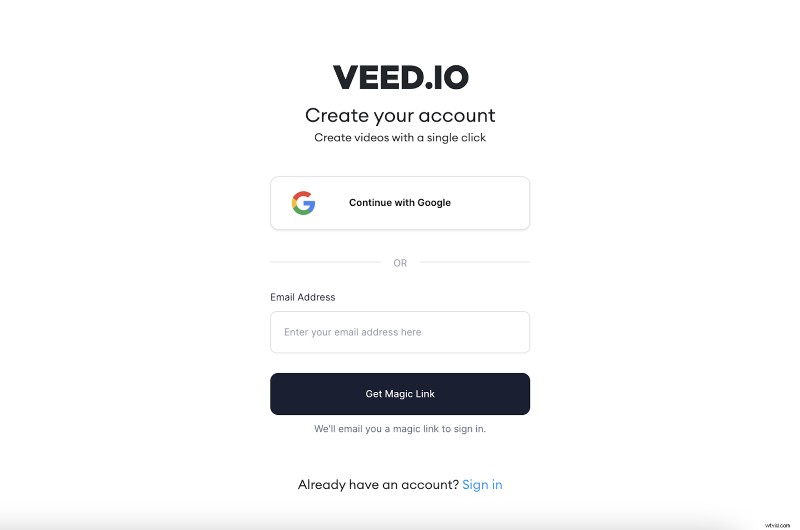
Step 6:Set up your brand kit with brand fonts and colors
If you have a pro or enterprise plan with VEED, you can set up your branding. Add your brand fonts, colors, and logo to your kit for professional-looking videos.
Step 7:Record or upload your video
Say you’re making a screencast or a hybrid type of video for your training topic. With VEED, it’s so easy to start because it’s already one of the options laid out for you in creating a new project.
You can either upload a file from your device, YouTube, or Dropbox. If you want to record a video instead, you have that option as well as recording your screen. VEED offers a screen recording Chrome extension for easy accessibility as well.
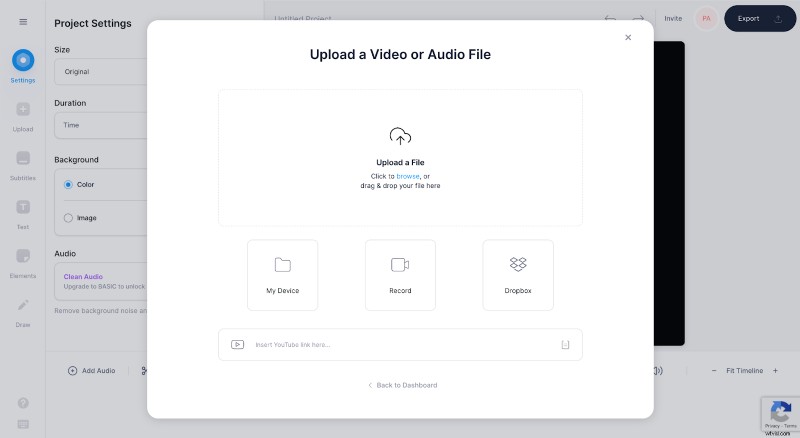
Step 8:Customize your video
Once you’re done with all the prep work from the earlier steps you can finally customize your video with edits!
Here are some key features you can use within VEED:
- Add subtitles: Increase comprehension, viewer retention, and engagement with subtitles. You can automatically add subtitles to video, upload an SRT subtitle file, or manually type them.
- Translate subtitles: Translate your video subtitles with the click of a button. Improve comprehension across a global audience.
- Draw on video: If you’re editing a screen recording, VEED’s screen recorder lets you draw on your screen. Our rainbow pen is so fun to use! If you’re editing a video you uploaded you can add annotations in the editor with the drawing tool.
Step 9:Review video
Before you share your training video, you’ll need feedback. AVEED’s collaboration features makes this frustration-free. Use the share button to share the video with people you want feedback from. They can then use the commenting feature to add feedback with a timestamp so you know exactly which part of the video they’re talking about.
You can also add teammates as collaborators into your VEED account.
Remember, the purpose of training videos is that they’re evergreen and won’t need replacing often. Take the extra time to make sure it’s perfect!
Step 10:Share your video
Sharing your video through VEED takes just a few clicks. Share the link in an email, add your video to Google slides or Powerpoint, or download the file and share it on social media.
5 examples of effective training videos
Here are five examples of the best training videos to refer to in the future.
1) Learn how to manage people and be a better leader
This is a whiteboard video from Workforce Singapore. It has gotten over 3.4 million views. It's also a great example of how you don’t need to be an expert video editor to get your idea across.
2) Apple — Inclusion &Diversity — Open
Apple is a visionary company who has made significant innovations. They want to convey this in their videos to help educate and attract outsiders who might want to join them.
If you take a look at his Open company video, you can see that their video makers have combined different video types to create it. It's simple and elegant.
3) How does the stock market work? - Oliver Elfenbaum
From animated videos targeting students to educators, TED-Ed has established an award-winning reputation. Committed to their slogan of “Ideas worth spreading”, TED-Ed’s videos have a consistent large viewership. This shows consistency and an ever-present branding in their content. This business training video, for one, had over 5 million views.
4) Motion Graphics Infographic - Ahrefs 2D
In under 2 minutes, this motion graphics video introduced the client–Ahrefs 2D. Since the client is an SEO platform, this could be a good reference for IT training videos.
Although it doesn’t have much viewership, this video gets the message across. It covers the important details and uses visually-appealing graphics to entice its audience.
5) How to Record Your Screen for FREE Online - VEED
Last but not the least, the perfect example of how to do a screen recording video using VEED is this one. It’s quick, comprehensive, and easy-to-follow.
The video combines screen recording with presenter-style videos into an effective how-to video. Our channel has gone from 0 to 33K subscribers with tutorial videos just like this.
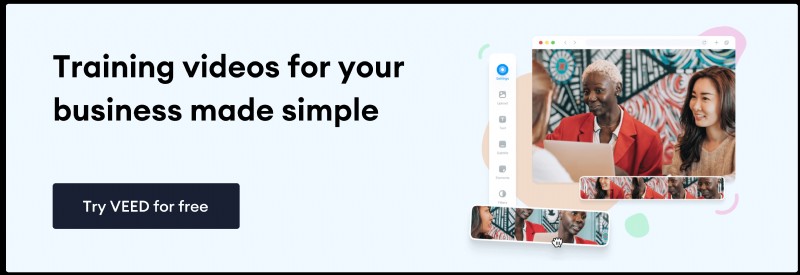
Frequently asked questions
How do you make training videos?
If you want to know how to make training videos, pick a topic of interest. Then, think about the most suitable type of training video for that topic. Once you’ve decided, make a script and storyboard. Finally, get your recording equipment ready and start filming.
How do you create an employee training video?
To create an employee training video, look for the most knowledgeable person to shoot your video with. Make the video more personal by doing a presenter style video if possible. You can also get creative professionals to help if your budget allows.
What should be included in a training video?
A training video should have well-scripted content with eye-catching visuals . It should also have a goal or intention and easily-recognizable branding . Keep it short but impactful.
How do you make interactive training videos?
You can make training videos interactive by embedding other educational materials in it. Create quizzes, examples, or workbooks learners can use while watching the video training.
Why are training videos useful?
Most of the population are visual and auditory learners. So, if you want to teach people, it will be easier to learn and understand in video format. Training videos engage your sense of sight and hearing. This can stimulate a deeper learning process.
Let's recap!
You now have everything you need to create training videos for your company (or any corporate setting). This investment of your time, energy and budget will save you money with video training material that can be played anytime anywhere.
Plus, not having to block out countless hours on your calendar for in-person training helps you and your team avoid burnout.
The last thing you want to disrupt this peace is clunky hard-to-use video editing software that eats away at your storage space.
With a simple online video editor like VEED you can easily edit videos like a pro online.
Here are some more things you can do!
- Record, collaborate, edit, review, and distribute with one tool: Say goodbye to a multi-tool workflow and hello to a simple but powerful tool that has your back for the whole process. With VEED you can record a training video, edit it, share it with teammates (or clients), and comment feedback!
- Automatic Subtitles: Add captions with the click of a button and customize them!
- Translations: Translate your video subtitles into 100 different languages.
- Cloud Storage: All your content lives safely inside your VEED workspace. Never take up precious storage space on your computer again!
- Screen recorder. Record training videos for free from the comfort of your browser!
- Online video editor: Do everything you need to make a polished video. Add text, music, sound effects, progress bars, annotations, images, compress video, combine videos, and more!
Curious about how VEED fits into your team’s workflow? Learn more about how we can simplify your video content workflow with VEED.
